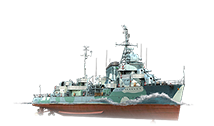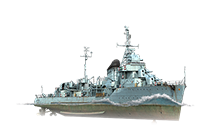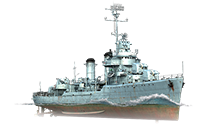艦艇:泛亞艦艇:修訂版本之間的差異
| 2018年9月1日 (六) 05:07的修訂版本 | 2018年9月1日 (六) 05:09的修訂版本 | |||
| 第 4 行: | 第 4 行: | |||
| ---- | ---- | |||
| [[File:Wows flag China.png|68px|frameless|left|link=]][[Image:Ship_PZSD506_Anshan.png|frame|right|link=Ship:Anshan|PLAN ''鞍山'', Tier VI 驅逐艦]]中國人民解放軍海軍(PLAN)正式組織於1950年9月,最初是在中國內戰(第二次國共內戰)期間從中華民國海軍脫離的部隊基礎上建立的,名義上是中國人民解放軍的一個分支。 | [[File:Wows flag China.png|68px|frameless|left|link=]][[Image:Ship_PZSD506_Anshan.png|frame|right|link=Ship:Anshan|PLAN ''鞍山'', Tier VI 驅逐艦]]中國人民解放軍海軍(PLAN)正式組織於1950年9月,最初是在中國內戰(第二次國共內戰)期間從中華民國海軍脫離的部隊基礎上建立的,名義上是中國人民解放軍的一個分支。 | |||
| + | ||||
2018年9月1日 (六) 05:09的修訂版本

人民解放軍海軍於20世紀50年代早期的擴張,主要是源自從蘇聯海軍購買的舊式護衛艦和驅逐艦,而中共則在蘇聯的幫助下於本國境內發展了造船和海軍建築技術。直到20世紀80年代末和蘇聯解體,人民解放軍海軍仍主要集中在沿海和河流作戰上。如今的中國大陸,在世界事務和海軍事務中的作用日益突出,這使得人民解放軍海軍的現代化和遠洋能力爆炸性增長,並在今天繼續擴大。中國人民解放軍至少經營著一艘現代航空母艦,這艘航母改造自前蘇聯時代的未完成艦艇,同時人民解放軍海軍也發展他們自己的航母建設計畫;1981年,他們擁有了第一艘核彈道飛彈潜艇,並繼續改進自己的各式水面艦艇和潜艇。
在1937年第二次中日戰爭開始的日子裏,中國海軍僅存的少量艦艇幾乎被消耗殆盡,直到第二次世界大戰鄰近結束,中國獲得自美國租借的一些艦艇,這支海上力量實際上才重新存在。重建的中華民國海軍擁有來自日本投降、賠償的艦艇與來自盟軍援贈的艦艇。但是在之後國內的政治風波之中,也就是1946年3月爆發的中國內戰期間,一些海軍部隊因為支持共產主義軍隊而叛離,使得中華民國海軍再次面臨被摧毀的境地。1949年10月,在蔣中正與國民革命軍在大陸上為毛澤東主導的共產黨挫敗之後,忠實的中華民國海軍部隊幫助和保護了超過100萬民眾從中國大陸撤離到臺灣島。
在韓戰爆發之後,西方國家的海軍,尤其是美國的海軍迅速地與中華民國海軍發展關係,並在此後的幾十年中支持他們。各國科技和海軍物資的轉移使中華民國海軍保持了現代性,儘管當地造船廠缺乏自主建造潜艇的能力,但已成功地委託建造了一批護衛艦、巡防艦和當地巡邏船加入海軍服役。整合了從美國、法國、德國和荷蘭購買的船隻,現代中華民國海軍得以遂行地方沿海控制和反封鎖措施的任務。
The young navy barely had time to develop assets before finding itself embroiled in the Korean War that broke out in June 1950. Bolstered by sales and donations of surplus World War II ships and material from friendly navies — as well as the active participation of navies from the member states of the United Nations — the ROKN quickly developed a reputation of aggressiveness, competence, and effectiveness in combat. The cease-fire that ended the war three years later has given way to a long, uneasy peace between the Republic of Korea (South Korea) on the southern half of the peninsula and the Democratic People's Republic of Korea (North Korea) on the northern half.
Since the end of the Korean War, the ROKN has concentrated its efforts on building naval forces to hold in check the Democratic People's Republic of Korea Navy (DPRKN) and their littoral naval capabilities. By the late 1970's, the growth of the South Korean economy and shipbuilding industry allowed them to grow their naval fleet with destroyers, frigates, and corvettes built indigenously. The modern ROKN continues to pursue missions of deterring aggression, protection of national maritime rights, and supporting the nation's foreign policy; as a part of their overall mission, it has engaged in several peacekeeping operations since the turn of the 21st century.
The end of the revolution marked the beginning of the development of the Indonesian Navy into a modern naval force. In accordance with the results of the Round Table Conference in December 1949, the TNI-AL was transferred a variety of war equipment and naval bases. Over the next decade, the TNI-AL enhanced its strength and improved its capabilities, reorganizing itself into distinct fleet forces, founding a Marine Corps — the Naval Commando Corps Command (Korps Komando-Angkatan Laut, or KKO-AL) — while building a focus on naval aviation. Their access to naval combat equipment grew in scope and size, both from the Netherlands and various other countries.
With their increased capabilities, the TNI-AL helped deal with a myriad of separatist movements that sprung up during the 1950s. By the height of the Cold War, a fledgling Indonesia had been largely saved from disintegrating from within and found itself embroiled in the larger conflict between the United States and Soviet Union that permeated the globe. A number of ex-Soviet Navy vessels found their way into TNI-AL service as the nation developed closer ties with the Soviets. Amidst the fallout of a September 1965 coup d'état, Indonesia severed ties with the Soviet Union. Several years of additional political turmoil ultimately resulted in a more democratic government that pursued closer ties with — and economic investment from — Western nations like the U.S.A. and United Kingdom.
The TNI-AL undertook a significant modernization effort in the 1980s, adding missile cruisers and other advanced technology to their arsenal. Currently, Indonesia fields the largest navy of any southeast Asian nation, and is notable for its capability to build modern missile cruisers and submarines via treaties with South Korea.
Siam later placed orders with Japanese shipyards for the construction of two coastal monitors, two submarines, and number of destroyers. These ships were involved in the 1932 coup d'état that transformed the absolute monarchy of Siam into the constitutional monarchy of Thailand, as well as the Franco-Thai War, which saw Thailand take advantage of the fall of France in 1940 to reclaim territory lost to the French during the conflicts of the 19th century. The conclusion of the Franco-Thai War was mediated by Japan and the treaty signed in Tokyo on 9 May 1941. Barely seven months later, Japan invaded and subjugated Thailand, forcing her government to declare war on the Allied powers in January 1942.
The conclusion of World War II in the summer of 1945 brought additional political turmoil to southeast Asia; the withdrawal of the Japanese and the weakening of colonial European forces left room for many countries to undergo significant leadership changes. Backed by the Soviet Union and China, communist ideology began to expand throughout the Indochina peninsula. With the aid of the United States — and royal influence — Thailand was able to resist communist influence and join the United Nations, allowing units of the RTN to participate in both the Korean and Vietnam Wars (in cooperation with South Korea and South Vietnam, respectively).
Today, the modern RTN continues to develop their overall capabilities, and is notable as the only southeast Asian nation to operate an aircraft carrier. Like their counterparts in Taiwan, local shipbuilding also has the ability to deliver modern frigates and destroyers without the need to purchase them from Western navies.






































